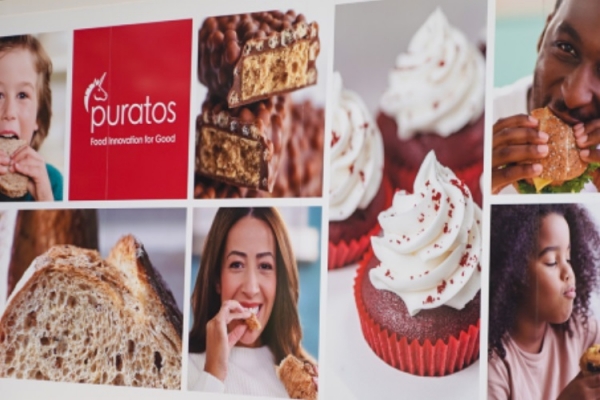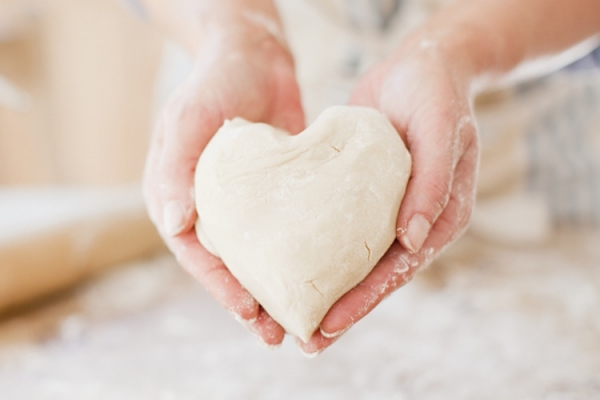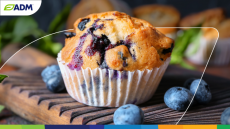Far from risking the inherent indulgence of baked goods, Puratos believes health is at the heart of consumer trends for 2024

The ingredient specialist for the bakery, patisserie and chocolate sectors celebrated its 100th anniversary at the beginning of 2020 – the timing almost poignant as the world was entering its biggest health crisis in eons. For a century, Puratos has been committed to innovation, but even more so on tailoring products to boost health and wellness.
A very good place to start
Founder Henri Groot and his son – who started the company in a Belgian garage with a vision to simplify the lives of bakers and confectioners – invested in R&D right from the start. The company’s first patent was for a leavening agent made from honey. This was followed by Pura-Malté – a bread made from toasted wheat germ, malt and bran, and a real innovator at the time.
According to the company’s website, the wheat germ was roasted in a machine invented by Prof Auguste Picard, the physicist notable for his exploration of both the upper stratosphere to study cosmic rays, and the depths of the sea in submersibles known as bathyscaphes.
Today, consumers take branded bread for granted, but back then, the oval shaped bread in its own wrapping was a driving USP.
“As a staple yet indulgent food, bread was the perfect place to start when it came to positively impacting consumer diets,” Sara De Pelsmaeker, group health & wellbeing director for Puratos, told Bakery&Snacks.
“On top of being healthy and tasty, the bread was also easily digestible. Pura-Malté was a real market breakthrough – labelled ‘the source of health and vitality’ – and its success helped Puratos to grow as a company.”
By the 1930s, Puratos was fast building a reputation for healthier innovations. By then, the young company had 36 products in its portfolio, including Germo Blé (a type of bread with a high vitamin content) and Pane’Or (a bread mix for those on diet).
A hundred years on and Puratos is as committed to creating the most nutritionally wholesome products possible, without compromising on taste, texture, quality or safety.
Back to the drawing board
De Pelsmaeker – who was appointed Group Health & Wellbeing director in February – told this site that although still rooted in these values, the company’s approach to health and wellbeing has certainly ramped up over the past decade to conform with ever-changing consumer trends.
“Bread remains at the core of our health and wellbeing strategy but we wanted to go back to the drawing board to discover how we can further diversify our offering and differentiate ourselves from the competition,” said De Pelsmaeker.
“With interest in functional food growing significantly, Puratos believed it had a responsibility to create healthier ingredients that helped customers keep up with consumer demand.
“Through our comprehensive proprietary research, we are able to identify and anticipate trends, which help guide our innovation pipeline.
“The Health and Wellbeing (H&WB) function and team act as facilitators for taking these findings, turning them into disruptive new ingredients and translating the products into a story to tell the market.
“Our focus is not only on today’s trends but also on creating a framework for the future and looking at what consumers in 2030 will want in their shopping baskets and on their tables. It is still work in progress but we have already established five health and wellbeing concepts, which will be fundamental to our R&D strategy over the coming years.”
Standout innovations
De Pelsmaeker said the H&WB team are an integral part of the company’s R&D and innovation team.
“Externally, we not only collaborate with our upstream ingredient suppliers but also with downstream parties such as product manufacturers, retailers and consumers. We are essentially a bridge between research and product development, turning insights into concepts and concepts into innovations that consumers truly crave.”
The H&WB team, for example, played a principal role in the launch of Topfil Finest, a new generation of fruit fillings that provide the sensation of freshly picked fruit in patisserie and bakery applications.
“Our fruit fillings already had an impressive array of health and wellbeing attributes, including no additives, preservatives, artificial colours or flavourings and clean labels. However, we saw an opportunity to push the boundaries of what can be achieved.”
She explained that by looking at factors such as trends, technologies, farm locations, fruit types, applications and marketing, “we established there was an appetite for higher fruit content in fillings and that we had the capabilities to cater to it. The fillings now contain up to 70% real fruit – allowing our customers to further reduce sugar content and improve the nutritional profile of their products.”
Another product the team worked closely on was Sapore Baiota, a dried Sapore wheat bran that creates a sourdough with the taste and texture the bread is famous for but packing an impressive fibre content.
“Traditionally, it has been a challenge for bakers to create a high fibre bread that would appeal to the average consumer in terms of taste and texture,” said De Pelsmaeker.
“The uniqueness of Sapore Baiota is it helps to preserve the texture consumers prefer in bread, while enhancing flavour and adding fibre. In fact, the ingredient has more than ten times the dietary fibre content of white flour – and just 5-10% needs to be added to create alternatives to white and wholemeal bread.
“The added bonus? It can potentially enable gut health claims, subject to compliance with legislation,” she added.
Is there such a thing as healthy indulgence?
Baked goods are historically viewed by consumers as a ‘guilty’ indulgence, so I asked De Pelsmaeker what the risks were in raising her profile and game in health and wellbeing.
“When it comes to consumer choice, taste is top priority but this needs to be balanced with other needs, such as health.
“Fortunately, indulgence and healthiness are not mutually exclusive. For example, we know that dark chocolate contains polyphenols – which have antioxidant properties and anti-inflammatory benefits – but it is also known for its superior sensorial experience.
“Manufacturers are answering to the call for ‘healthy indulgence’ through the creation of premium products. More people are willing to pay a premium price for a luxurious product that offers health benefits compared with a cheaper alternative that is heavily processed and high in sugar and fat.”
She noted the company’s latest Taste Tomorrow research supports this theory, with two-thirds of consumers disregarding the cheapest item for the quality they know and trust. This is the case across all categories, including bread, chocolate, cakes and sweet pastries.
“In essence, with the right product, consumers do not have to compromise on ideals or indulgence,” added De Pelsmaeker.
Tops trends for 2024
As we head into the new year, De Pelsmaeker believes the market trends to shine will be the ones Puratos is already focused on.
Clean label
“Clean label stands out, as more consumers are looking for ingredients lists that are as natural as possible – and increasingly, organic. What is interesting about clean label is that it is no longer a trend – it is a necessity.
“Manufacturers, retailers and consumers alike expect to see clean labels. In fact, more than one in four consumers globally is willing to pay more for products with natural ingredients lists, according to Taste Tomorrow.”
Plant-based
“This is another major trend that shows no signs of slowing. Plant-based eating has become synonymous with sustainability and healthier diets but it is now being recognised for its cost mitigation benefits.
“With rising raw material prices and supply chain instability, plant-based ingredients – alternatives eggs, butter and milk – often offer more cost-efficient options for manufacturers. The biggest challenge is replicating the functionality of the animal-based ingredients in plant-based products, while ensuring that taste, safety and quality are not compromised.”
Sugar reduction
“This is driven largely by changing legislation. Around the world, we are seeing governments implement more stringent rules and regulations around sugar content in food. While there are incentives aimed at reducing intake, there are also restrictions on producing foods high in sugar.
“Manufacturers are therefore actively looking for solutions that can aid sugar reduction, without the need to reformulate, sacrifice indulgent taste or risk non-compliance.
“Rather than having to just take sugar out, manufacturers are realising the advantages of putting natural sugar in their recipes through fruit fillings and inclusions.”
Gut health
“One of the biggest opportunities is in gut health. We are seeing lots of research into how feeding the gut microbiome with certain foods can positively impact health. And the benefits extend far beyond digestion, from supporting cognitive function to improving immunity.
“Awareness of how high fibre content or fermented ingredients can boost gut goodness is growing in bakery. And as the connection between ‘happy gut’ food becomes even better understood and more ingrained, demand is likely to escalate, and more opportunities will open up.
“As a company we want to meet the challenge and produce gut-friendly ingredients that pack a punch in bakery,” concluded De Pelsmaeker.






















